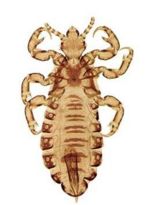Lice
Jump to navigation
Jump to search
| This article has been peer reviewed but is awaiting expert review. If you would like to help with this, please see more information about expert reviewing. |
Phthiraptera introduction
Lice are obligate ectoparasites of every avian and most mammalian species. They are only a few millimeters long and like fleas, are wingless but unlike fleas are dorsoventrally flattened.
Lice are host specific, permanent parasites which cause pediculosis. The louse saliva and faeces contain allergenic substances which cause irritation, rubbing, licking and skin damage leading to decreased host productivity.
Mammalian lice species have a single pair of claws on the ends of stout legs, whereas avian lice species have a double claw on each leg.
There are two main groups of veterinary importance, the mallophaga (chewing lice) and anoplura (sucking lice).
Anoplura
Also known as sucking lice
- Narrow head
- Thorax wider than the head
- Powerful legs
- Piercing mouthparts
- Feed on blood and tissue fluids
- Heavy infestations can cause anaemia
- Species occur only on mammals
Life cycle
- The whole life cycle takes 2-3 weeks
- The louse spends its whole life on the animal
- It can however survive for one week off the animal
- In some species parthenogenesis can occur
- Close contact transmission can occur
1. Eggs
- Known as nits
- Cemented to hairs
2. Nymphs
- Nymphs hatch from the egg (no larval stage)
- Undergoes several moults
3. Adults
- Females can lay up to 10 eggs per day
